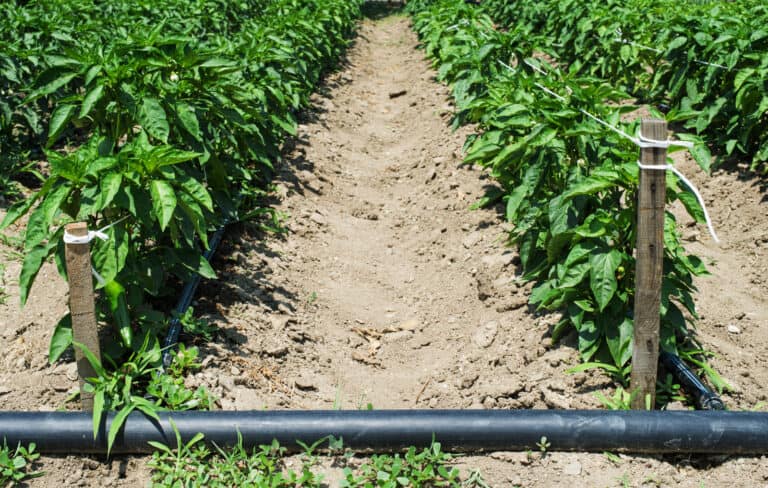How to deal with aphids on your pepper plants
Are pesky aphids wreaking havoc on your beloved pepper plants? Aphids are a common garden pest that, unfortunately, love peppers.
Read on for expert tips on managing aphids: from natural remedies to clever tricks, we have an arsenal of solutions to help you reclaim your pepper plants and ensure a bountiful harvest.
What are aphids, and why do they love peppers?
Aphids are small, soft-bodied insects that attach themselves to the leaves of plants and suck out sap. Unfortunately, the leaves of pepper plants are abundant in sap for them to feast on.
These tiny pests are typically oval-shaped with skinny legs and measure around 2 to 4 millimeters in length. While green and black are the most common colors, aphids can also be found in shades of pink, brown, and yellow. The specific type of aphid encountered depends on location, climate, and plant type.

Aphids have a symbiotic relationship with ants, as ants consume the honeydew excretions of aphids.
Signs of aphid damage on pepper plants
Identifying aphid damage on your pepper plants is crucial for timely intervention. You can take appropriate measures to control the infestation by recognizing the signs. Here are some indicators to look out for:
Presence of aphids:
The most direct way to identify aphid damage is by spotting the insects. Take a close look at the underside of the leaves, where aphids tend to congregate. If possible, hold the leaves against the light to make the aphids more visible.
Dark spots on leaf veins:
Dark spots along the leaf veins can be a telltale sign of aphid feeding. These spots indicate areas where the aphids have pierced the plant tissue and extracted sap. Over time, this can weaken the plant and affect its overall health.
Increased ant activity:
Ants and aphids often have a mutually beneficial relationship. If you notice an increase in ant populations around your pepper plants, it could indicate a concurrent aphid infestation. Ants are attracted to the honeydew excreted by aphids and will actively protect them. Monitoring ant activity can help you gauge the severity of the aphid problem.
Leaf abnormalities:
Aphids can cause visible changes in the leaves of pepper plants. Look for signs like leaves drying up, curling, or turning yellow. These symptoms often result from aphid feeding and sap extraction, which disrupt the plant’s normal functioning.
Benefits of aphids in your garden
Although aphids can be detrimental to your plants, it’s essential to recognize that they also serve a purpose within garden ecosystems. Understanding the beneficial aspects of aphids can provide a more balanced perspective on their role in your garden. Here are some key benefits of aphids:
- Food source for beneficial insects: Aphids are a primary food source for beneficial insects, including ladybugs (lady beetles) and parasitic wasps. These beneficial insects are natural predators that help maintain a balance in your garden by preying on harmful creatures such as hornworms and other plant pests. By providing a readily available food source, aphids contribute to the survival and proliferation of these beneficial insects.
- Supporting ecosystem balance: Insects, including aphids, are integral to complex garden ecosystems. Each insect species plays a role in the web of life, contributing to the overall balance and diversity of the ecosystem. Recognizing this ecological perspective reminds us that eradicating aphids entirely should not be the ultimate goal. Instead, as a gardener, your aim should be to manage the population to minimize damage while maintaining a healthy ecosystem.
By understanding the benefits of aphids, you can holistically approach pest management. Rather than striving for complete eradication, focus on maintaining a balanced garden ecosystem that promotes the presence of beneficial insects while controlling the population of aphids through targeted strategies. This approach allows you to strike a balance between protecting your plants and supporting your garden’s overall health and biodiversity.
How to kill aphids on pepper plants
When it comes to combating aphid infestations on your pepper plants, there are several approaches you can take. The method you choose will depend on your preferences, whether you prefer to use pesticides or explore alternative options, the severity of the aphid population, and your budget. Here are some effective methods to consider:
How to get rid of aphids without pesticides
When dealing with aphids on your pepper plants, there are effective control methods that don’t involve the use of pesticides. Here are some strategies to consider:
Squishing Aphids: If you have a small number of aphids, a straightforward approach is to squish them manually. Using gloves, simply crush the aphids with your hand, eliminating them from your plants.
Spraying with Water: For established and sturdy plants, spraying cold water on the aphids can help dislodge them from the leaves. Use a hose with a strong stream of water to knock the aphids off the plant. However, exercise caution with young or fragile plants, as this method may cause damage.
Ladybugs: Ladybugs are natural predators of aphids and can be an effective means of control. You can purchase live ladybugs from nurseries, hardware stores, or online. Release them onto your pepper plants, and they will feed on the aphids, helping to reduce their population.

Companion Planting: Employing companion plants can repel aphids, trap them, or attract more predators to your garden. Consider the following companion planting techniques:
- Trap plants: Plant sacrificial trap crops like nasturtiums, cosmos, and zinnias alongside your peppers. These plants attract aphids, diverting them away from your pepper plants.
- Border trap crops: Plant taller trap crops around the perimeter of your main pepper crop. Research suggests that taller trap crops can effectively deter aphids and mites. Ensure the trap crops are taller than those they protect for optimal results (Ben-Issa et al., 2017).
- Repellant plants: Certain plants have repellent properties against aphids. Garlic, catnip, and dill may repel aphids from your garden area. Intercropping your main crop with onions and garlic has been found to significantly reduce aphid populations, according to a study (Sarker et al., 2009).
- Predator-attracting plants: Some plants can attract natural predators of aphids, such as ladybugs and parasitic wasps. Calendula, marigolds, alyssum, and herbs like mint, thyme, and fennel are known to attract these beneficial insects, which feed on aphids.
Aluminum Foil or Plastic Mulch: Placing aluminum foil or plastic mulch around the base of your pepper plants can act as a deterrent and repellant for aphids. Research has shown the effectiveness of aluminum foil and reflective mulch in deterring aphids (Loebenstein et al., 1975; Adlerz & Everett, 1968).
Pesticide options for aphid control
When dealing with aphids, various pesticide options are available, including both natural and synthetic. However, it’s essential to exercise caution and use them responsibly to avoid harm to your ecosystem. Here are some pesticide options to consider:
- Neem oil: Neem oil is a natural pesticide derived from the neem tree. With a history of use spanning hundreds of years, neem oil contains Azadirachtin, which acts as a repellent and reduces insect feeding. It can also disrupt the hormonal system of insects, thereby reducing their reproduction (Bond et al., 2012).
- Capsaicin: Capsaicin is the compound responsible for the spicy heat in chili peppers. It can serve as a deterrent to aphids. You can purchase commercial capsaicin sprays or make your own by chopping chili peppers, soaking them in water, straining the mixture, and using the remaining liquid in a spray bottle. Chili pepper extract has been shown to decrease the density of aphids and spider mites (Tomita & Endo, 2007).
- Diatomaceous earth (DE): DE is a natural pesticide made from fossilized aquatic organisms called diatoms. When insects come into contact with DE, it absorbs the oils and fats from their exoskeletons, causing them to dry out (Bunch et al., 2013).
- Insecticidal soap: Insecticidal soap contains potassium salts of fatty acids, which are effective against soft-bodied insects like aphids and mites. It does not harm hard-bodied insects, including beneficial insects like ladybugs and certain beetles.
Downsides of using pesticides
Using natural or synthetic pesticides comes with certain downsides that should be considered. One major drawback is the potential disruption they can cause to your ecosystem. Pesticides are indiscriminate, meaning they can kill or harm not only the target pests, such as aphids but also beneficial insects and other organisms. This can lead to an imbalance in the ecosystem and negatively impact pollinators, which play a crucial role in the reproduction of certain crops.
Another downside is the non-selective nature of pesticides. They can affect a wide range of pests when applied rather than explicitly targeting aphids. This means that beneficial insects, such as predators and pollinators, may also be harmed, reducing their population and disrupting your garden’s natural pest control mechanisms.
It’s important to note that certain pesticides, even natural ones, can cause irritation to humans. For example, diatomaceous earth (DE), a natural pesticide, can cause skin and eye irritation, and significant inhalation may lead to respiratory discomfort. Similarly, capsaicin, found in chili peppers used as a pesticide, can cause irritation to the eyes, skin, and respiratory system.
Therefore, it’s crucial to consider the potential ecological and health risks associated with pesticide use. Whenever possible, alternative methods of pest control that are less harmful to the environment should be explored to maintain a healthy and balanced garden ecosystem.
Dealing with aphids on indoor pepper plants
Similar approaches can be used to treat the infestation when dealing with aphids on indoor pepper plants.
The first step is to isolate any affected plants to prevent the insects from spreading. Manual removal is an effective method for small numbers of aphids, which can involve squishing the aphids, cutting off affected leaves, or physically knocking them off. Sticky traps can also be utilized to catch aphids and prevent their further movement.
In more severe cases, insecticidal soap or neem oil can be used to control the aphid population. These options provide practical ways to address aphid infestations on indoor pepper plants and restore the health of your plants.
As you navigate the world of aphid control for your pepper plants, it’s essential to reflect on your priorities as a dedicated gardener. Each of us faces different circumstances and considerations, from personal preferences to budgetary constraints.
Take a moment to evaluate your unique situation and determine the right aphid solution that aligns with your gardening philosophy. Whether you opt for natural remedies, companion planting, or carefully selected pesticides, remember that the goal is to maintain a healthy balance in your garden ecosystem. You can bid farewell to those pesky aphids by carefully selecting the best approach.
References:
- W. C. Adlerz , P. H. Everett, Aluminum Foil and White Polyethylene Mulches to Repel Aphids and Control Watermelon Mosaic, Journal of Economic Entomology, Volume 61, Issue 5, 1 October 1968, Pages 1276–1279, https://doi.org/10.1093/jee/61.5.1276
- Ben-Issa R, Gomez L, Gautier H. Companion Plants for Aphid Pest Management. Insects. 2017; 8(4):112. https://doi.org/10.3390/insects8040112
- Bond, C.; Buhl, K.; Stone, D. 2012. Neem Oil General Fact Sheet; National Pesticide Information Center, Oregon State University Extension Services. http://npic.orst.edu/factsheets/neemgen.html.
- Bunch, T. R.; Bond, C.; Buhl, K.; Stone, D. 2013. Diatomaceous Earth General Fact Sheet; National Pesticide Information Center, Oregon State University Extension Services. http://npic.orst.edu/factsheets/degen.html.
- Loebenstein, G., Alper, M., Levy, S. et al. Protecting peppers from aphid-borne viruses with aluminum foil or plastic mulch. Phytoparasitica 3, 43–53 (1975). https://doi.org/10.1007/BF02981220
- Sarker, P., Rahman, M., & Das, B. (2009). Effect of Intercropping with Mustard with Onion and Garlic on Aphid Population and Yield. Journal of Bio-Science, 15, 35–40. https://doi.org/10.3329/jbs.v15i0.2200
- Tomita, M., & Endo, H. (2007). Using capsaicin as a less toxic insecticide. Combined Proceedings International Plant Propagators’ Society, 57, 728–734.






